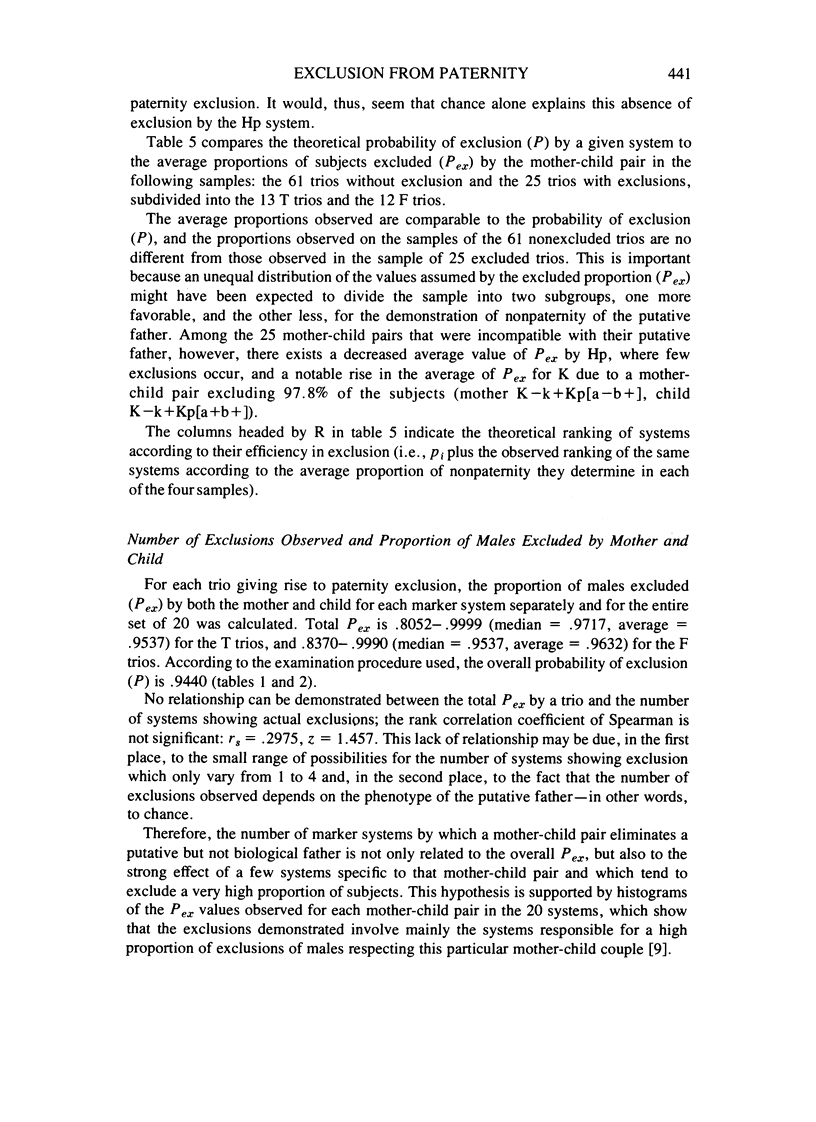Abstract
The proportion of exclusion for a given mother-child pair is the proportion of males excluded from the paternity of this child of a known mother and may be calculated given both the child's and mother's phenotypes and the population gene frequencies. Its expected value in the population is equal to the probability of exclusion, which expresses a laboratory's capability to exclude from paternity nonbiological fathers.
In a sample of 171 families examined for 20 genetic systems at the National Blood Group Reference Laboratory, 25 exclusions of putative fathers were detected. The ranking by efficiency of the systems used in these exclusions fits the “expectation of their efficiency,” and the average proportion of males excluded by the child's and mother's phenotypes is not different from the expected proportion. Additionally, the repetition of exclusions in an incompatible putative father-mother-child trio is not dependent on the overall proportion of males excluded by the mother and the child, but rather on some high values of the proportion of excluded men in some specific systems.
Here, formulas and some factors modifying these parameters as well as a more efficient sequence of examinations to exclude paternity than has previously been used are given. Using this sequence, laboratories which carry out several analyses per day can work by levels of five examinations at a time, done in a particular order, to obtain a rather rapid exclusion of certain families.
Full text
PDF












Selected References
These references are in PubMed. This may not be the complete list of references from this article.
- Chakraborty R., Schull W. J. A note on the distribution of the number of exclusions to be expected in paternity testing. Am J Hum Genet. 1976 Nov;28(6):615–618. [PMC free article] [PubMed] [Google Scholar]
- Chakraborty R., Shaw M., Schull W. J. Exclusion of paternity: the current state of the art. Am J Hum Genet. 1974 Jul;26(4):477–488. [PMC free article] [PubMed] [Google Scholar]
- Chastang C. l., Salmon D., Grémy F., Seger J., Salmon Ch. Validation de paternité au sein d'un trio père-mère-enfant à partir des marqueurs génétiques. Description d'un programme d'aide à la décision. Détermination de la séquence optimale d'examens. Nouv Rev Fr Hematol. 1978 Apr 14;20(1):111–122. [PubMed] [Google Scholar]
- Chastang PATER: a program for parenthood diagnosis. Comput Programs Biomed. 1976 Mar;5(4-2):251–258. doi: 10.1016/0010-468x(76)90053-2. [DOI] [PubMed] [Google Scholar]
- Lanset S., Gerbal A., Liberge G., Ropartz C., Salmon C. Le phénotype Ael: étude immunologique et génétique. Nouv Rev Fr Hematol. 1970 May-Jun;10(3):389–399. [PubMed] [Google Scholar]
- Salmon D. B., Brocteur J. Probability of paternity exclusion when relatives are involved. Am J Hum Genet. 1978 Jan;30(1):65–75. [PMC free article] [PubMed] [Google Scholar]
- Salmon D., Yvart J. Fréquences géniques de 17 systèmes de polymorphisme. Etude sur un échantillon de sujets vivant dans la Région Parisienne. Rev Fr Transfus. 1974 Dec;17(4):295–304. doi: 10.1016/s0035-2977(74)80042-8. [DOI] [PubMed] [Google Scholar]
- Seger J. Fréquences dans la population parisienne des gènes correspondant au polymorphisme de l'adénosine déaminase, de la 6-phosphogluconate déshydrogénase et de l'estérase D. Rev Fr Transfus Immunohematol. 1977 Dec;20(4):575–583. doi: 10.1016/s0338-4535(77)80062-7. [DOI] [PubMed] [Google Scholar]
- Seger J., Salmon D. Fréquences des phénotypes de la s.G.P.T. et de la fraction C'3 du complément to dans la population parisienne. Rev Fr Transfus Immunohematol. 1977 Jun;20(2):331–336. doi: 10.1016/s0338-4535(77)80098-6. [DOI] [PubMed] [Google Scholar]


